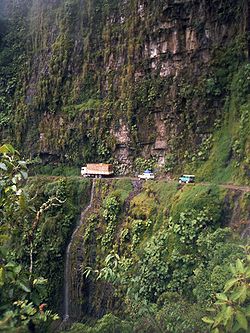Yungas Road
16°17′25″S 67°49′38″W / 16.290253°S 67.827126°W
This article's tone or style may not reflect the encyclopedic tone used on Wikipedia. (October 2024) |

The Yungas Road, commonly referred to as Death Road, is a 64-kilometre (40 mi) long cycle and vehicle route linking the city of La Paz with the Yungas region of Bolivia. It was built in the 1930s by the Bolivian government to connect the capital city of La Paz to the Amazon Rainforest in the north part of the country. Large amounts of its construction was done by Paraguayan prisoners during the Chaco War. Several sections of the road are less than 3 metres (9.8 ft) wide. Due to the common occurrence of rain, fog, landslides, cascades, steep slopes and cliffs, it is largely considered the most dangerous road in the world.[1][2][3]
Unlike in the rest of the country, the Yungas Road is a left-hand traffic road, which allowed drivers to better gauge the distance between their vehicles and the edge of the road.[4] It has since been replaced by a newer, two-lane asphalt road featuring guardrails and drainage systems.[5]
Known for its extreme danger with 3,500 metres (11,500 ft) of descent, the Death Road draws about 25,000 tourists per year and has become a popular destination for adventure tourism, particularly mountain biking.[6][7] At least 18 cyclists have died on the road since 1998.[8]
History
[edit]Parts of this road were built by Paraguayan prisoners that were captured after Chaco War in the 1930s. It was of one of the few routes that connect the Amazon jungle up north, with the city of La Paz.[9]
A new alternative route, now part of Route 3, was built during a 20-year period ending in 2006. The modernization included enlarging the carriageway from one to two lanes; asphalt paving; bridges, drainage, guardrails, and the building of a new section between Chusquipata and Yolosa, bypassing the most dangerous sections of the original road. As the result, North Yungas Road is now mainly used for bicycles, motorcycles, and walking. Up until 2006, the North Yungas Road was the sole route for traveling from Coroico to La Paz. In 2009, the Bolivian government built a new road along the adjacent mountain range.[citation needed] The asphalt road features two lanes, drainage systems and guardians.
Traffic accidents
[edit]
Because of the steep slopes, the lack of guardrails, and the narrow width of the road (as little as 3 meters in some places), the road was especially dangerous for vehicular traffic. Weather conditions further increased the danger; rain and fog would reduce visibility, while muddy terrain and loose stones could impair traction. It was famous for its dangerous conditions and deaths from traffic accidents, averaging around 209 accidents and 96 deaths per year.[10] In 1995, the Inter-American Development Bank dubbed it as the most dangerous road in the world.
In July 1983, a bus fell from the Yungas Road into a canyon, killing more than one hundred passengers in one of the worst road accidents in Bolivia.[11]
Until the mid-1990s, the accident rate was even worse, with 200 to 300 drivers falling off the cliff each year.[12]
In 2011, the total number of accidents was around 114, the second most in Bolivia after the road between La Paz and Oruro. Of these accidents, 42 people died.[13]
Gallery
[edit]-
A cliff along the road
-
The old North Yungas Road before the new road opened
-
Tourists mountain-biking downhill
References
[edit]- ^ Browne, Jenny (2005). "The World's Most Dangerous Road (A Bolivian Detour)". Fourth Genre: Explorations in Nonfiction. 7 (2): 9–19. doi:10.1353/fge.2005.0031. ISSN 1522-3868. JSTOR 41938821.
- ^ Whitaker, Mark (11 November 2006). "The world's most dangerous road". BBC News. Retrieved 7 July 2012.
- ^ Dufraigne, Annabelle (8 June 2024). "The 9 Most Dangerous Roads in the World". Architectural Digest. Retrieved 19 September 2024.
- ^ Oishimaya Sen Nag (25 April 2017). "North Yungas Road - Bolivia's Most Treacherous Road". worldatlas.com. Retrieved 24 April 2019.
- ^ Villa, Micaela. "Se reducen los accidentes en las carreteras paceñas". La Razón (in Spanish). Retrieved 4 April 2019.
- ^ Geoghegan, Tom (16 May 2010). "Cycling the world's most dangerous road". BBC News Online. Retrieved 16 May 2010.
- ^ "Death Road Tours". Bolivia Hop. Retrieved 4 April 2019.
- ^ "Death Road / Itinerary". Barracuda Biking. Retrieved 4 April 2019.
- ^ Meghji, Shafik (2 May 2022). "The world's most dangerous road". BBC News. Retrieved 19 September 2024.
- ^ Azcui, Mabel (28 December 2006). "La 'carretera de la muerte'". El País Internacional (in Spanish). Retrieved 7 July 2012.
- ^ "Bolivia: The big drop". www.telegraph.co.uk. 13 April 2002. Retrieved 24 March 2023.
- ^ Mora, Maria A. (13 November 2020). "Ciclismo por la Carretera de la Muerte en Bolivia". Universal Traveller (in Spanish). Archived from the original on 14 January 2023. Retrieved 3 December 2020.
- ^ Villa, Micaela (20 December 2011). "Se reducen los accidentes en las carreteras paceñas". La Razón (in Spanish). Archived from the original on 21 February 2019. Retrieved 7 July 2012.
External links
[edit] Media related to Yungas Road at Wikimedia Commons
Media related to Yungas Road at Wikimedia Commons



